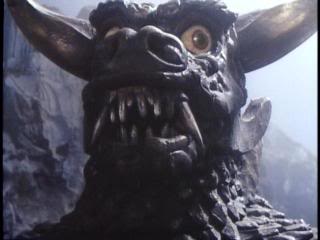Pulgasari: History And Review
- Stephen Miller

- Feb 13, 2021
- 10 min read

Happy Chinese New Year 2021! The year of the ox! Last year was the year of the rat and I dove into the history of the lost kaiju film, Nezura. This year being the year of the ox, I want to dig into a more controversial movie. One that kaiju fans still talk about to this day and that movie is Pulgasari. What I will be doing here is give you a history lesson of the movie and give my review on the movie. The source I will be using for the history of the movie will be from the book titled "A Kim Jong-Il Production: The Incredible True Story of North Korea and the Most Audacious Kidnapping in History." I recommend reading it to get a more detailed version of the movie's history.
The History of Pulgasari:
From 1954 to 1975, Godzilla became a world wide cultural icon. Godzilla became so popular that North Korea's Supreme leader, Kim Jong-Il, was a fan of the movies himself. If there are any other interests this dictator had other than torturing people it was watching movies and over time, he would have collected over a thousand bootleg copies of movies outside of North Korea. This lead to his desire to produce movies of his own. His father, Kim Il-Sung, didn't think highly of the idea of his son producing movies. He saw it as a distraction. However, Kim Il-Sung also saw potential to spread propaganda pieces by letting his son produce films.
Since the people of North Korea are not experienced in making movies at all. This lead to Kim Jong-Il kidnapping South Korean director, Shin Sang-Ok, and actress, Choi Eun-Hee in 1978. Shin and Choi were married at one point and Choi was starred in the majority of Shin's films. They would divorce later on and Choi would remarry South Korea's President, Park Chung-Hee.
Using his knowledge from James Bond films and learning that Shin would chase after Choi if she was in danger, Kim invited Choi to Hong Kong for to audition for a movie. As it turned out, Choi was kidnapped at the location spot where the audition was suppose to be held. While Shin was in America hoping to restart his film career, he would get a message about Choi's disappearance in Hong Kong. Just as Kim predicted, Shin flew to Hong Kong to search for Choi and was kidnapped by North Korean operatives.

While Shin was being tortured at North Korea's prison, Choi was being chauffeured around by Kim to plays and banquets to get Choi to feel comfortable around him and talked into switching sides. When Kim and Choi were first introduced, Kim broke the ice with a joke saying, "Come on, Madame Choi, what do you think: How do I look? I'm small as a midget's turd, aren't I?" Choi almost laughs unsure how to react to Kim's ice breaker. During her time spent hanging around with Kim, she realizes she needed to put on her best acting performance to save her life. Choi would even come into contact with Catherine Hong, an abductee from China. The two would become friends and learning that Catherine is Catholic, Choi decides to convert to Catholicism and Catherine would perform Choi's baptism in an area where they couldn't be found by North Korean authorities.
During his two and a half years spent in prison, Shin would two attempts to escape. After his second attempt, he was banned from talking with the other inmates. There were many times he would try to commit suicide or starve himself to death. All attempts failed every time as the guards would catch his every attempt. Shin would regularly receive the poorest medical treatment or be force fed just so Shin is kept alive and Sung would interrogate Shin afterwards telling him how pitiful he looked. Shin would even describe the unimaginable horror of the living conditions in the prison and the rules he had to follow.
On March 6, 1983, Shin would come to an agreement with the Deputy Director that he wouldn't try escaping North Korea anymore if he and Choi lived together. Shin would finally reunite with Choi and meet Kim Jong-Il face to face. Kim would announce that Shin would become his official film advisor, Choi as his official representative for all Korean women, and that Shin and Choi will hold a wedding ceremony on the Great Leader's birthday - April 15th. Shin realized that if he and Choi had never divorced, then they would have been celebrating their twenty-ninth wedding anniversary.
Shin would begin making films for North Korea on October 20, 1983, with his first film An Emissary of No Return, which was based on a stage play that was written by Kim Jong-Il. Other movies Shin directed includes Love, Love, My Love (1984), Runaway (1984), Salt (1985), The Tale of Shim Chong (1985), and his final movie, Pulgasari (1986).
After watching The Return of Godzilla, Kim decided it was time for North Korea to have a monster movie to claim as their own. Shin and his crew were unfamiliar with the techniques used in the Godzilla films, so this required having to "outsource" people that are. Kim sent agents to Japan and kidnapped the special effects crew and Godzilla actor, Kenpachiro Satsuma, from the Godzilla parent studio, TOHO Co., tricking them into thinking they were being hired for a big-budget Hollywood film that was being filmed in China.
Even though Kim Jong-Il loves Godzilla movies, he would only talk to the Korean film crew and would stay far away from the Japanese film crew due to his anti-Japanese sentiments. Satsuma and Shin would actually sit down to a conversation and Satsuma was fascinated that Shin was hoping to make a film in Japan one day. Satsuma would then ask Shin if he was planning to go back to South Korea and Shin's response was, "It would be too complicated, politically, to go back." The conversation simply ended with that.
Pulgasari would run behind schedule constantly. This is due to constant power outages and inadequate special effects equipment. Either Satsuma or the special effects director, Teroyuki Nakano, would have to request new equipment after North Korean technicians would steal the tools they needed.
By December 28th, 1985, Pulgasari wrapped up filming and was released several months later hailing as Shin's best film in North Korea. Shin and Choi would be sent together on tours to promote the movie at film festivals. One of those film festivals Shin and Choi would be sent to was in Vienna, Austria. After arriving in Vienna, the couple would find themselves staying at the Intercontinental Vienna and Shin noticed the person at the front desk was Japanese. The night preceding the escape, he contacted the front desk and asked for the Japanese employee to come up to the room. The man knocked on the door and Shin pulled him in quickly, whispered to him that he was seeking asylum in the United States, slipped a note in the man's hand, and shoved him out the door. The note read in English: "We are Shin Sang-Ok and Choi Eun-Hee, husband and wife. We want to take refuge in the U.S. Embassy." And below that it read in Japanese: "We are not diplomats, but we have diplomatic passports. Please report to the Austrian police that we illegally possess these diplomatic passports and have us arrested and escorted to the police station. We are staying at the Intercontinental Hotel in room 911." This was a forewarning to the United States embassy to be expecting them.

The next morning, Shin, Choi, and reporter, Akira Enoki, entered a taxi while the body guards were ordered to take another cab and to follow them. After entering the taxi, Shin tells the driver to take them to the embassy and to step on it. The North Korean agents would chase Shin and Choi into a traffic congestion forcing the pair to run on foot the rest of the way. They arrived at the embassy and told them their story. By 1:30 PM, an American official walks into the room with Shin and Choi. He hands Choi a pink rose and he says with a smile, "Welcome to the West." Choi takes the rose and breaks down in tears of joy.
Shin and Choi managed to gain asylum in America and had to live in America for many years working in the film industry before they were allowed to return to South Korea. In a statement, Kim Jong-Il would deny claims that Shin Sang-Ok and Choi Eun-Hee were kidnapped, claimed they defected voluntarily, and made false accusations of embezzling large amounts of money that was planned to use to finance a Genghis Khan movie out of North Korea when the couple escaped.
During his time living in the United States, Shin Sang-Ok would write a loose remake of Pulgasari titled The Legend of Galgameth, which uses a similar story as Pulgasari and since this is a movie made for kids the monster is switched out for a monster that looks more kid friendly.
Review:

In feudal Korea, a king that rules with an iron fist will realize that a rebellion of peasants are not the only things he needed to worry about as Pulgasari, a monster made from rice and devours iron, stomps his way to his castle to put an end to his reign of terror.
As it stands, Pulgasari is the only monster film that is banned in the United States, but there is so much debate over the context of the movie. A lot of Godzilla fans have even speculated that Pulgasari was secretly an anti-Communist propaganda movie and it is easy to see why.
Most of the movie revolves around a rebellion fighting off an evil emperor and the monster is fighting for the people since the soul of a girl's dead father resonates inside the monster. The emperor and his army represents the evils of capitolism and the monster, Pulgasari, is suppose to represent Kim Jong-Il. But after devouring all of the iron from the castle and killing the emperor, Pulgasari turns to devour the iron from the people. So the people are threatened by Pulgasari to give him their iron. The girl, Ami, even warns that Pulgasari has become a huge threat and that if there is no more iron in Korea then they would be forced to go to war with other countries just so Pulgasari can survive. The only way Pulgasari was able to be killed was by accidentally devouring the girl.
Imagine being the Supreme Leader of North Korea, you self-insert yourself into a movie as a monster that helps the people, and some where in the movie you're told that you're a threat to the whole world and needed to die. If that isn't anti-communism, then at least it is an anti-Kim Jong-Il movie. It had to have flown over Kim Jong-Il's head if he gave the movie so much praise. Shin Sang-Ok was even asked if Pulgasari was secretly an anti-communism movie, but he denied the claims.
To this day, people are still debating whether Pulgasari is pro or anti-communist and that is one of the reasons the movie is so popular. The other reason why is because it's not a movie made available in the United States. Finding a physical copy would be considered a rare item. You would have to go to Japan, at least, just to find a copy on DVD. The surprising thing is that if you just want to watch the movie it's not as hard as people may think. If you go on YouTube and search for Pulgasari, the whole movie is the first video that pops up. It was uploaded eight years ago and I remember when I first watched the movie, I thought, "There is no way YouTube would allow a whole movie to stay on here for long. It will be gone eventually." To this day, still seeing it listed on YouTube still shocks the hell out of me.
The setting for Pulgasari is actually quite different from the usual. Instead of having a monster rampaging around modern day cities, Pulgasari takes place during Korea's medieval era with a hint of fantasy like magic. The medieval setting even does something creative. Normally in monster movies, the monster would be fighting off tanks, fighter jets, helicopters. In Pulgasari, the movie had the monster burned alive in a cage, arrows and cannons were fired at him, and even exorcists were sent in to ward off the angry spirit residing within Pulgasari. If you ever wanted to see a Godzilla movie take place in the medieval era, Pulgasari is as close as it's going to get.
Despite all of that, the story itself is a slow crawl and it takes almost half the movie before the monster has fully grown and the movie feel really slow as you're forced to watch horrible action scenes with god awful music. If you take away the fact that Pulgasari was made in North Korea, the movie would not be taken as lightly by fans of monster movies.
The only time we get to see Pulgasari start destroying stuff is when he arrives at the castle, which is pretty close to the end of the movie. This is probably my favorite part of the movie because it is really like watching a Godzilla movie and we start to see Pulgasari turn on the people that he protected. Plus, the miniatures and the castle is amazingly detailed it is all because it was built by the special effects crew from TOHO Co.
The base design around Pulgasari is based on an ox. Some scenes does make Pulgasari look scary and menacing, but in scene where we see a close up at his face he looks goofy. His eyes look like they're bulging out from his head makes Pulgasari very cartoony looking.
He doesn't have abilities like radioactive breath or spit fireballs. He did shoot a fire ball out from his mouth in one scene, but that was only because he caught the cannon ball and shot it back at his attackers. The only real abilities he has are durability and strength. Unlike Godzilla, Pulgasari is not as durable. He can still get physically damaged. As I have listed three paragraphs ago Pulgasari has been burned alive, had cannons fired at him, and exorcisms were performed to ward off Pulgasari and nothing worked.
Final Thoughts:
Pulgasari takes some creative liberties with the medieval setting, but the only thing the movie has going for it is that it is made in North Korea and the speculative discussions on whether or not the movie is secretly an anti-communist movie. If this was a movie made in South Korea or anywhere else, then the movie would have been regarded for decent special effects and monster design, but everything else like the story and the music would be forgettable and nothing to rag home about. It is available to watch on YouTube if you are curious enough to check it out, but I recommend reading the book A Kim Jong-Il Production by Paul Fischer instead.
Have you watch Pulgasari? If so, what are your thoughts on the movie? Have you read the book by Paul Fischer? Leave a comment in the comments section on your thoughts on the movie and its history. Make sure to follow me on Facebook, Twitter, Minds, MeWe, and Gab to stay up to date for more news, reviews, and discussions.
























Comments